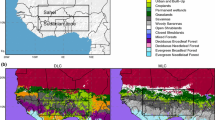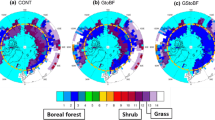Abstract
Much work is under way to identify and quantify the feedbacks between vegetation and climate. Palaeoclimate modelling may provide a mean to address this problem by comparing simulations with proxy data. We have performed a series of four simulations of the Last Glacial Maximum (LGM, 21,000 years ago) using the climate model HadSM3, to test the sensitivity of climate to various changes in vegetation: a global change (according to a previously discussed simulation of the LGM with HadSM3 coupled to the dynamical vegetation model TRIFFID); a change only north of 35°N; a change only south of 35°N; and a variation in stomatal opening induced by the reduction in atmospheric CO2 concentration. We focus mainly on the response of temperature, precipitation, and atmosphere dynamics. The response of continental temperature and precipitation mainly results from regional interactions with vegetation. In Eurasia, particularly Siberia and Tibet, the response of the biosphere substantially enhances the glacial cooling through a positive feedback loop between vegetation, temperature, and snow-cover. In central Africa, the decrease in tree fraction reduces the amount of precipitation. Stomatal opening is not seen to play a quantifiable role. The atmosphere dynamics, and more specifically the Asian summer monsoon system, are significantly altered by remote changes in vegetation: the cooling in Siberia and Tibet act in concert to shift the summer subtropical front southwards, weaken the easterly tropical jet and the momentum transport associated with it. By virtue of momentum conservation, these changes in the mid-troposphere circulation are associated with a slowing of the Asian summer monsoon surface flow. The pattern of moisture convergence is slightly altered, with moist convection weakening in the western tropical Pacific and strengthening north of Australia.










Similar content being viewed by others
References
Bamzai AS, Marx L (2000) COLA AGCM simulation of the effect of anomalous spring snow over Eurasia on the Indian summer monsoon. Q J R Meteorol Soc 126:2575–2584
Barnett TP, Dumenil L, Schlese U, Roeckner E (1989) The effect of Eurasian snow cover on regional and global climate variations. J Atmos Sci 46:661–685
Becker BD, Slingo JM, Ferranti L, Molteni F (2001) Seasonal predictability of the Indian Summer Monsoon: what role do land surface conditions play? Mausam 52:175–190
Berger A (1978) Long-term variations of daily insolation and quaternary climatic changes. J Atmos Sci 35:2362–2367
Berger A (2001) The role of CO2, sea-level and vegetation during the Milankovitch-forced glacial-interglacial cycles. In: Proceedings “Geosphere-Biosphere Interactions and Climate”. Cambridge University Press, New York, pp 119–146
Blanford HF (1884) On the connexion of the Himalayan snowfall with dry winds and seasons of droughts in India. Proc R Soc Lond 37:3–22
Bonan GB, Pollard D, Thompson SL (1992) Effects of boreal forest vegetation on global climate. Nature 359:716–718
Brovkin V (2002) Climate–vegetation interactions. J Phys IV PR 10:57–72
Bush ABG (2002) A comparison of simulated monsoon circulations and snow accumulation in Asia during the mid-Holocene and at the Last Glacial Maximum. Global Planet Change 32:331–347
Cox PM, Huntingford C, Harding RJ (1998) A canopy conductance and photosynthesis model for use in a GCM land surface scheme. J Hydrol 212–213:79–94
Cox PM, Betts RA, Bunton CB, Essery RLH, Rowntree PR, Smith J (1999) The impact of new land surface physics on the GCM simulation of climate and climate sensitivity. Clim Dyn 15:183–203
Cox PM, Betts RA, Jones CD, Spall SA, Totterdell IJ (2001) Modelling vegetation and the carbon cycle as interactive elements of the climate system. In: Pearce R (ed) Meteorology at the millennium. Academic, New York, pp 259–279
Crowley T, Baum S (1997) Effect of vegetation on an ice-age climate model simulation. J Geophys Res 102(D14):16463–16480
Crucifix M, Loutre MF (2002) Transient simulations over the last interglacial period (126–115 kyr bp): feedback and forcing analysis. Clim Dyn 19:419–433
Crucifix M, Betts RA, Cox PM (2005b) Vegetation and climate variability: a GCM modelling study. Clim Dyn 24:457–467 DOI 10.1007/s00382-004-0504-z
Crucifix M, Betts RA, Hewitt CD (2005a) Pre-industrial-potential and last glacial maximum global vegetation simulated with a coupled climate-biosphere model: diagnosis of bioclimatic relationships. Global and Planet Change 45:295–312 DOI 10.1016/j.gloplacha.2004.10.001
Dickson RR (1984) Eurasian snow cover versus Indian monsoon rainfall—an extension of the Hahn-Shulka results. Q J R Meteorol Soc 23:171–173
Eltahir EAB (1996) Role of vegetation in sustaining large-scale atmospheric circulation in the tropics. J Geophys Res 101(D2):4255–4268
Essery RLH, Best MJ, Betts RA, Cox PM, Taylor CM (2003) Explicit representation of subgrid heterogeneity in a GCM land-surface scheme. J Hydrometeorol 4(3):530–543
Ganopolski A, Rahmstorf S, Petoukhov V, Claussen M (1998) Simulation of modern and glacial climates with a coupled global model of intermediate complexity. Nature 391:351–356
Hahn D, Shukla J (1976) An apparent relationship between Eurasian snow cover and Indian monsoon rainfall. J Clim 33:2461–2462 DOI 10.1175/1520–0469
Harrison SP, Braconnot P, Joussaume S, Hewitt CD, Stouffer RJ (2002) Comparison of palaeoclimate simulations enhances confidence in models. EOS Trans Am Geophys Union 83:447
Harvey LDD (1988) On the role of high latitude ice, snow and vegetations feedbacks in the climatic response to external forcing changes. Clim Change 13:191–224
Hewitt CD, Senior CA, Mitchell JFB (2001) The impact of dynamic sea-ice on the climatology and climate sensitivity of a GCM: a study of past, present, and future climates. Clim Dyn 17:655–668
Hewitt CD, Stouffer RJ, Broccoli AJ, Mitchell JFB, Valdes PJ (2003) The effect of ocean dynamics in a coupled GCM simulation of the last glacial maximum. Clim Dyn 20:203–218 DOI 10.1007/s00382–002–0272–6
Inness PM, Slingo JM, Woolnough SJ, Neale RB, Pope VD (2001) Organization of tropical convection in a GCM with varying vertical resolution; implications of the Madden-Julian Oscillation. Clim Dyn 17:777–793
Kubatzki C, Claussen M (1998) Simulation of the global bio-geophysical interactions during the Last Glacial maximum. Clim Dyn 14:461–471
Levis S, Foley JA, Pollard D (1999) CO2, climate, and vegetation feedbacks at the Last Glacial Maximum. J Geophys Res 104(D24):31191–31198
Otterman J, Chou MD, Arking A (1984) Effects of nontropical forest cover on climate. J Appl Meteorol 23:762–767
Peltier WR (1994) Ice age paleotopography. Science 265:195–201
Pope VD, Stratton RA (2002) The processes governing horizontal resolution sensitivity in a climate model. Clim Dyn 19:211–236
Pope VD, Gallani ML, Rowntree PR, Stratton RA (2000) The impact of new physical parametrizations in the Hadley Centre climate model—HadAM3. Clim Dyn 16:123–146
Rayner NA, Horton EB, Parker DE, Folland CK, Hackett RB (1996) Version 2.2 of the global sea-ice and sea surface temperature data set, 1903–1994. CRTN74, Hadley Centre for Climate Prediction and Research Met Office, Bracknell, RG12 2SY
Rodwell MJ, Hoskins BJ (2001) Subtropical anticyclones and summer monsoons. J Clim 14:3192–3211
Turcq B, Cordeiro RC, Sifeddine A, Simoes FFL, Albuquerque ALS, Abrao JJ (2002) Carbon storage in Amazonia during the Last Glacial Maximum: secondary data and uncertainties. Chemosphere 49(8):821–835
Vernekar AD, Zhou J, Shukla J (1995) The effect of Eurasian snow cover on the Indian monsoon. J Clim 8:248–266
Viterbo P, Betts AK (1999) Impact on ECMWF forecasts of changes to the albedo of the boreal forests in the presence of snow. J Geophys Res 104:27803–27810
Voldoire A, Royer JF (2004) Tropical deforestation and climate variability. Clim Dyn 22:857–874 DOI 10.1007/s00382–004–0423–z
Wilson MF, Henderson-Sellers A (1985) A global archive of land cover and soils data for use in general circulation climate models. J Climatol 5:119–143
Wyputta U, McAvaney BJ (2001) Influence of vegetation changes during the Last Glacial Maximum using the BMRC atmospheric general circulation model. Clim Dyn 17:923–932
Xue Y, Shukla J (1996) The influence of land surface properties on Sahel climate. Part II: afforestation. J Clim 9:3260–3275
Yasunari T, Kitoh A, Tokioka T (1991) Local and remote responses to excessive snow mass over Eurasia appearing in the northern spring and summer climate—a study of the MRI GCM. J Meteorol Soc Jpn 69:473–487
Zhang H, Henderson-Sellers A (1996) Impacts of tropical deforestation. Part I: process analysis of local climatic change. J Clim 9:1497–1517
Zhang YS, Li T, Wang B (2004) Decadal change of the spring snow depth over the Tibetan Plateau: the associated circulation and influence on the East Asian summer monsoon. J Clim 17(14):2780–2793
Acknowledgements
This work is supported by the UK Government Meteorological Research Program and EU contract nr EVK2-CT-2002-00153 on Models and Observations to Test clImate Feedbacks (MOTIF).
Author information
Authors and Affiliations
Corresponding author
Rights and permissions
About this article
Cite this article
Crucifix, M., Hewitt, C.D. Impact of vegetation changes on the dynamics of the atmosphere at the Last Glacial Maximum. Climate Dynamics 25, 447–459 (2005). https://doi.org/10.1007/s00382-005-0013-8
Received:
Accepted:
Published:
Issue Date:
DOI: https://doi.org/10.1007/s00382-005-0013-8




